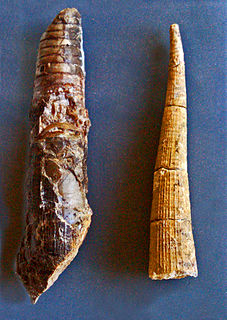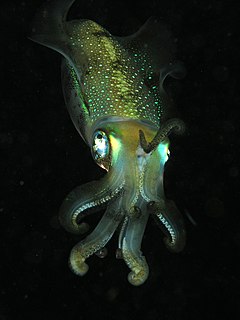
Orthoceras is a genus of extinct nautiloid cephalopod restricted to Middle Ordovician-aged marine limestones of the Baltic States and Sweden. This genus is sometimes called Orthoceratites. Note it is sometimes misspelled as Orthocera, Orthocerus or Orthoceros.

Orthoceratidae is an extinct family of actively mobile carnivorous cephalopods, subclass Nautiloidea, that lived in what would be North America, Europe, Asia, Africa, and Australia from the Ordovician through Triassic from 490—203.7 mya, existing for approximately 286.4 million years.
Pseudorthocerida is an order of generally straight longiconic Orthoceratoids with a subcentral to marginal cyrtochoanitic siphuncle composed of variably expanded segments which may contain internal deposits that may develop into a continuous parietal lining.(Sweet 1964). Cameral deposits are common and concentrated ventrally. Apices typically have a slight to moderate exogastric curvature
Paraloxoceras is a genus of straight shelled, orthoconic nautiloid cephalopods, now extinct, that lived during the Early Carboniferous. Fossils have been found in Europe and central Asia; the type, P. konincki, named by Flower, came from Belgium.
Tienocerasis an orthoceratoid genus from the Permian of China (Hunan). Orthoceratoids are slender conical or near cylindrial, orthoconic, nautiloid cephalopods from the Paleozoic. Nautiloids, which include a number of different extinct orders, were far more diverse and numerous in the past, but are represented today by only two closely related genera.
Pseudactinoceras is an extinct nautiloid cephalopod included in the order Pseudorthocerida and the namesake of the family Pseudactinoceratidae.

Kionoceras is an extinct nautiloid cephalopod genus included in the orthocerid family Kionoceratidae with scattered worldwide distribution from the Middle Ordovician to the Lower Permian. Kionoceratids are orthocerids with prominent longitudinal ornamentation on their shells, sometimes augmented by secondary transverse ornamenttion. Orthocerids are, of course, prehistoric nautiloides with generally straight and elongate shells, mostly with central or subcentral siphuncles.
Winnipegoceras is an extinct nautiloid genus from the Ordovician belonging to the Order Discosorida.
Zittelloceras is an extinct genus of nauiloids from the order Oncocerida which are among a large group of once diverse and numerous shelled cephalopods, now represented by only a handful of species.

Paraphragmitidae is an extinct family of actively mobile aquatic carnivorous cephalopods belonging to the subclass Orthoceratoidea endemic to what would be Asia and Europe during the Silurian living from 436—418.7 mya, existing for approximately 17.3 million years.

Pseudorthoceratidae is an extinct family of actively mobile aquatic carnivorous cephalopods belonging to the subclass Orthoceratoidea endemic to what would be North America, Asia, and Europe during the Silurian living from 460.5—251 Ma, existing for approximately 209.5 million years.

Dawsonoceratidae is an extinct family of orthoconic nautiloid cephalopods that lived in what would be North America and Europe from the Late Ordovician through the Middle Devonian from about 480–390 mya, existing for approximately 90 million years.
Cycloceras is an extinct nautiloid cephalopod genus from the Carboniferous of Western Europe, of unknown affinity with the orthocerida
Donacoceras is an extinct genus of actively mobile carnivorous cephalopod, essentially a Nautiloid that lived in what would be North America during the Ordovician from 460.5—443.7 mya, existing for approximately 16.8 million years.
Geisonocerina is an extinct genus from the carnivorous nautiloid cephalopod order Orthocerida that lived in what would be North America, Europe, and Asia during the Ordovician through Permian from 449—290 mya, existing for approximately 159 million years.
Mongoceras is an extinct orthoconic nautiloid cephalopod found in the Silurian of China and Siberia. It is included in the Orthocerida. The family in undetermined.
Parasphaerorthoceras is an extinct orthocerid genus, a nautiloid cephalopod, that lived in what would be Europe and north Africa during the Silurian from 422.9—418.1 mya, having existed for approximately 4.8 million years.
Protobactrites is an extinct nautiloid cephalopod belonging to the Orthoceratoidea that lived in what would be Europe and Asia during the Ordovician and Silurian from 466–421.3 mya, existing for approximately 44.7 million years.
Orthoceratoidea is a subclass, formerly considered an infraclass or a superorder, that comprises Cephalopoda orders that have orthoconic to slightly cyrtoconic shells and central to subcentral siphuncles in which there may be internal deposits. Currently, Orthoceratoidea comprises the orders Dissidocerida, Ascocerida, Pseudorthocerida, Lituitida and Orthocerida.
Eusthenoceras is a genus of Early Carboniferous nautiloid cephalopods with a large depressed, apically curved shell assigned to the Pseudactinoceratidae,. The siphuncle is central or located between the center and venter. Necks are cyrtochoanitic, otherwise siphuncle shape and structure are unknown making inclusion in the Pseuactinoceratidae tentative. Siphuncle segments are probably inflated.





